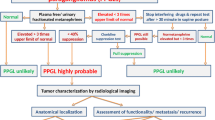Abstract
Pheochromocytoma is a rare but extremely treacherous neuroendocrine tumor causing manifestations by secreting catecholamines into the circulation. It is usually fatal if unrecognized. Manifestations can mimic many diseases and cause erroneous diagnoses. Approximately 15% are malignant, 18% extra-adrenal, and 20% familial. Plasma or urinary metanephrines are approximately 98% sensitive for detecting pheochromocytomas. They can be localized by MRI and CT; 131I- and 123I-metaiodobenzylguanidine (MIBG) are highly specific and 81% to 90% sensitive, respectively. Suspect pheochromocytoma in patients with sustained or paroxysmal hypertension or in normotensives having manifestations of hypercatecholaminemia. Surgical removal is usually curative; chemotherapy and radiotherapy are palliative for malignant pheochromocytomas.
Similar content being viewed by others
References and Recommended Reading
Sutton M, Sheps SG, Lie JL: Prevalence of clinically unsuspected pheochromocytoma: review of a 50-year autopsy series. Mayo Clin Proc 1981, 56:354–360.
McNeil AR, Blok BH, Koelmeyer TD, et al.: Pheochromocytomas discovered during coronal autopsies in Sydney, Melbourne and Auckland. Aust N Z J Med 2000, 30:648–652.
Manger WM, Gifford RW Jr: Clinical and Experimental Pheochromocytoma. Cambridge, MA: Blackwell Science; 1996.
Whalen RK, Althausen AF, Daniels GH: Extra-adrenal pheochromocytoma. J Urol 1992, 147:1–10.
Pacak K, Lineham WM, Eisenhofer G, et al.: Recent advances in genetics, diagnosis, localization, and treatment of pheochromocytoma. Ann Intern Med 2001, 135:315–329.
Neumann HP, Bausch B, McWhinney SR, et al.: Germ-line mutations in nonsyndromic pheochromocytoma. N Engl J Med 2002, 346:1459–1466. Reports that an increasing number of apparently sporadic pheochromocytomas have genetic mutations, which classifies them as familial.
Neuman HPH, Denkel E, Brambs H, et al.: Pancreatic lesions in the Von Hippel-Lindau syndrome. Gastroenterology 1991, 101:465–471.
Bergland BE: Pheochromocytoma presenting as shock. Am J Emerg Med 1989, 7:44–48.
Newell KA, Prinz RA, Pickleman J, et al.: Pheochromocytoma multisystem crisis: a surgical emergency. Arch Surg 1988, 123:956–959.
Lenders JWM, Pacak K, Walther MM, et al.: Biochemical diagnosis of pheochromocytoma: Which test is best? JAMA 2002, 287:1427–1434. Reports the remarkably high degree of sensitivity and specificity of determining metanephrine and normetanephrine in plasma or urine for detecting pheochromocytoma.
Raber W, Raffesberg W, Bischof M, et al.: Diagnostic efficacy of unconjugated plasma metanephrines for detection of pheochromocytoma. Arch Intern Med 2000, 160:2957–2963.
Eisenhofer G, Goldstein DS, Walther MM: Biochemical diagnosis of pheochromocytoma: How to distinguish true from false-positive test results. J Clin Endocrinol Metab 2003, 88:2656–2666. Reports the value of using clonidine suppression of plasma normetanephrine for distinguishing true from false-positive test results.
Manger WM, Gifford RW Jr: Pheochromocytoma. In Endocrine Mechanisms in Hypertension. Edited by Laragh JH, Brenner BM, Kaplan NM. New York, NY: Raven Press; 1989:19–59.
Jebara VA, Uva MS, Farge A, et al.: Cardiac pheochromocytomas. Ann Thorac Surg 1992, 53:356–361.
Fink IJ, Reinig JW, Dwyer AJ, et al.: MR imaging of pheochromocytomas. J Comput Assist Tomogr 1985, 9:454–458.
Baker EM, Spritzer C, Blinder R, et al.: Benign adrenal lesions mimicking malignancy on MR imaging: report of two cases. Radiology 1987, 163:669–671.
Stowers SA, Gilmore P, Sterling M, et al.: Cardiac pheochromocytoma involving the left main coronary artery presenting with exertional angina. AM Heart J 1987, 114:423–427.
Sisson JC, Frager MS, Valk TW, et al.: Scintigraphic localization of pheochromocytoma. N Engl J Med 1981, 305:12–17.
Jalil ND, Pattou FN, Combemale F, et al.: Effectiveness and limits of preoperative imaging studies for the localizations of pheochromocytomas and paragangliomas: a review of 282 cases. Eur J Surg 1998, 164:23–28.
van der Harst E, de Herder WW, Bruining HA, et al.: [123I]-metaiodobenzylguanidine and [111In]-octreotide uptake in benign and malignant pheochromocytomas. J Clin Endocrinol Metab 2001, 86:685–693.
Ilias I, Yu J, Carrasquillo JA, et al.: Superiority of 6-[18F]-fluorodopamine positron emission tomography versus [131I]-metaiodobenzylguanidine scintigraphy in the localization of metastatic pheochromocytoma. J Clin Endocrinol Metab 2003, 88:4083–4087. Reports the development of a highly sensitive and specific radiopharmaceutical agent for detecting pheochromocytoma and its metastases.
Manger WM: Editorial: In search of pheochromocytomas. J Clin Endocrinol Metab 2003, 88:4080–4082.
Mantero F, Massimo T, Arnoldi G, et al.: A survey on adrenal incidentaloma in Italy. J Clin Endocrinol Metab 2000, 85:637–644.
Manger WM, Gifford RW Jr: Pheochromocytoma: How to diagnose, how to treat. J Clin Hypertension 2002, 4:62–72.
Neumann HPH, Reincke M, Bender BU, et al.: Preserved adrenocortical function after laparoscopic bilateral adrenal sparing surgery for hereditary pheochromocytoma. J Clin Endocrinol Metab 1999, 84:2608–2610.
Loh K-C, Fitzgerald PA, Matthay KK, et al.: The treatment of malignant pheochromocytoma with iodine-131 metaiodobenzylguanidine (131I-MIBG): a comprehensive review of 116 reported patients. J Endocrinol Invest 1997, 20:648–658.
Shapiro B, Sisson JC, Wieland DM, et al.: Radiopharmaceutical therapy of malignant pheochromocytoma with [131I]-metaiodobenzylguanidine: results from 10 years experience. J Nucl Biol Med 1991, 35:269–276.
Averbush SD, Steakley CS, Young RC, et al.: Malignant pheochromocytoma: effective treatment with a combination of cyclophosphamide, vincristine, and dacarbazine. Ann Intern Med 1988, 109:267–273.
Takahashi K, Ashizawa N, Minami T, et al.: Malignant pheochromocytoma with multiple hepatic metastases treated by chemotherapy and transcatheter arterial embolization. Intern Med 1999, 38:349–354.
Pacak K, Fojo T, Golstein DS, et al.: Radiofrequency ablation: a novel approach for treatment of metastatic pheochromocytoma. J Natl Cancer Inst 2001, 93:648–649.
Sisson JC, Shapiro B, Shulkin BL, et al.: Treatment of malignant pheochromocytomas with 131I-metaiodobenzylguanidine and chemotherapy. Am J Clin Oncol 1999, 22:364–370.
Author information
Authors and Affiliations
Rights and permissions
About this article
Cite this article
Manger, W.M., Eisenhofer, G. Pheochromocytoma: Diagnosis and management update. Current Science Inc 6, 477–484 (2004). https://doi.org/10.1007/s11906-004-0044-2
Issue Date:
DOI: https://doi.org/10.1007/s11906-004-0044-2




